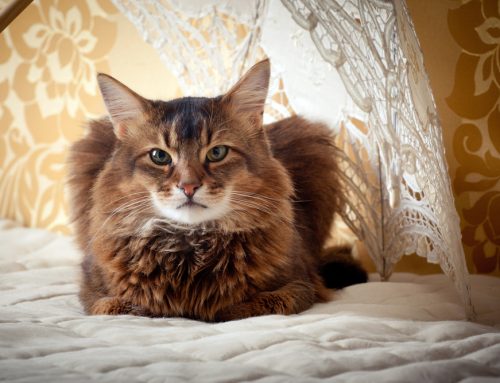Welcome to the first ever Chatham Animal Clinic (CAC) howl-iday home tour! Unlike a traditional tour, we will be evaluating the homes not for their decor, food, or ambiance, but for pet safety. If you didn’t already know, pet hazards overflow—like Santa’s magical bag—during the howlidays. Let’s jump right in and join the next tour, to see what risky situations await. Come on inside, it’s cold out there!
Pine dining—your pet and the Christmas tree
After entering the home, you first notice a towering Christmas tree in the foyer. Each branch is wrapped with twinkling lights that reflect the sparkle from the streams of silver tinsel and garland. Glass ornaments are perched delicately among the needles, like birds settling in for the night. Also, you can tell the tree is the real deal, because of its soft, scented branches.
CAC’s findings: While impressive, this display lands squarely on Santa’s naughty list for pet safety. The tree’s multiple dangers include:
- Twinkle lights — Dogs and cats can be electrocuted if they chew the light wiring. Check cords daily, and keep your pet away from the tree unless they are supervised.
- Tinsel and garland — Cats cannot resist shiny tinsel, and may chew and swallow these decorations. The linear shape can form an intestinal blockage that requires life-saving surgery.
- Glass ornaments — Low-hanging ornaments are easy for pets to reach and break, and can lacerate their mouth, face, or paws. Leave the bottom branches bare, to keep ornaments beyond your pet’s reach.
- Real tree — All trees must be securely inserted in their base to prevent tipping. Real trees present an extra danger because they need toxic chemical additives in the water, to preserve the tree. Ensure the water is changed daily.
Exquisite taste—your pet and the dining room table
Our tour moves to the dining room, where the table looks like a picture postcard—the candlelight glistens, the centerpiece turkey is surrounded by dishes of stuffing, garlic potatoes, candied yams, and corn-on-the cob, and the glasses blush with a festive red wine. The side table is an equally dizzying display, including pies, cakes, chocolates, and cookies. The hostess has not overlooked a single thing—or has she?
CAC’s findings: Holiday dishes commonly contain the top toxic foods for pets. While our stomachs rumble with happiness, our sensible side has to dock some points for the many dangerous delectables, including:
- Turkey — Boneless white meat is OK for pets in small amounts, but keep bones, skin, and fatty trimmings out of their reach, to prevent choking, intestinal obstruction, and painful pancreatitis.
- Garlic, onions, and leeks — This trio makes an appearance in many holiday dishes, and can damage red blood cells.
- Corn-on-the-cob — Dogs commonly swallow corn cobs, which need surgical removal by a veterinarian.
- Alcohol — Pets are tempted by the sweet aroma, and, like people, can suffer alcohol poisoning.
- Xylitol — Sugar-free desserts may include this low calorie sweetener, which causes severe hypoglycemia and potential liver failure in dogs.
- Chocolate — Stimulant compounds in chocolate cause dangerous arrhythmias and affect the nervous system. Chocolate candies may contain pet-toxic macadamia nuts or raisins.
An eye for design—your pet and holiday decorations
The living room now beckons. You walk under the mistletoe. The fireplace is lit, and a holly and candle wreath centerpiece sits on the coffee table beside a colorful gingerbread house. Poinsettias abound. Peppermint potpourri steeps on the bookshelf, and wafts through the room. The room is ready for Christmas, but some last traces of Thanksgiving, including pilgrim figurines, and mini pumpkins and gourds, still sit on a side table.
CAC’s findings: The living room is set for relaxing and reclining and soaking up the holiday spirit, but we feel on edge about the multiple burn hazards and toxins present. Before you smooch your pooch under the mistletoe, you should know:
- Always use a fireplace screen — Pets find the lapping flames and shooting sparks irresistible.
- Flameless candles are best for pets — Avoid face and paw burns, and accidental fires.
- Many holiday plants are toxic — Mistletoe and holly are harmful to pets, if ingested. Poinsettias cause minor irritation, but are not toxic.
- Pets can mistake small decorations for toys or food — Figurines, ornaments, and gourds may be chewed and swallowed, creating intestinal obstruction.
- Potpourri can sicken cats and avians — Essential oils and potpourri can cause kidney failure in cats, and respiratory injury in birds.
Strange relations—your pet and houseguests

We complete our tour, return to the entryway, and stand by the open front door to thank our hosts. The front door is open as the children race wildly in and out of the front door. The real holiday guests—the hosts’ families—arrive with bags of gifts in tow.
CAC’s findings: Our tour is over, but we must close with a few points about the holiday hazards the last scenario poses to pets:
- The open front door — Pets often run away during the busy holiday season, fearful of all the strangers and the commotion. Ensure your pet wears proper identification tags and is microchipped—and that the information is current and the chip is registered.
- Overwhelming scenarios — Hustle and bustle isn’t always holly-jolly. Give your pet a quiet place to escape the excitement.
- Packed poisons — Advise house guests to store medications, mints, and gum on counters or shelves inaccessible to pets—not on the nightstand—and keep room doors closed.
Now it’s your turn—take a tour of your home, looking for any pet safety hazards. Do your decorations pass the test, or do they need editing? For additional questions about pet holiday safety, or if your pet gets into trouble despite your best efforts, contact Chatham Animal Clinic.







Leave A Comment